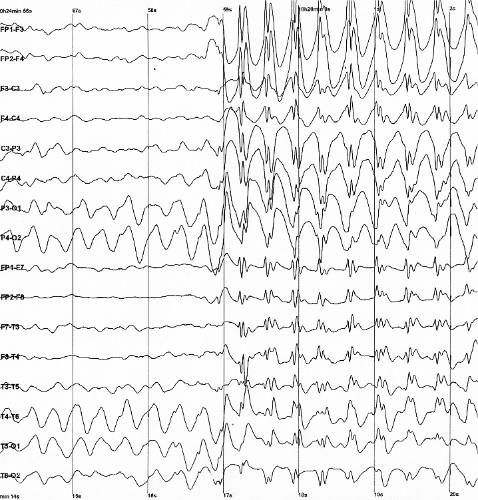Epilepsy is a common condition that causes seizures (uncontrolled movements or fits); the most severe seizures consist of generalised convulsions that affect many muscle groups in the body and are accompanied by unconsciousness (a grand mal attack). Other patients experience a transient trance-like state (petit mal). Epilepsy often begins in childhood. Epilepsy is normally diagnosed after a person has their first seizure. There are two main causes of epilepsy: brain injuries and chemical or metabolic imbalances in the brain. Any brain injury may result in epilepsy, but in many cases there is no identifiable cause; when injury is the cause, there is a latent period before the onset of epilepsy. The physical events that cause epilepsy in early life include birth traumas, infections of the brain or meninges, and congenital abnormalities, while alcohol, drugs, tumours and cerebrovascular accidents tend to be the causes in later life. Status Epilepticus occurs when a prolonged seizure or a series of seizures occurring in quick succession. Sudden Unexpected Death in Epilepsy (SUDEP) is rare, and occurs in about 1% of the population of patients with epilepsy. Low blood glucose, poor oxygenation of the blood and disturbances of blood electrolytes such as sodium or calcium ions also can precipitate seizures in patients who are susceptible; organ failure of the kidneys or liver may contribute to these changes. Genetic abnormalities may alter the excitability of neurones and predispose to the seizures. Epilepsy is investigated by taking a full history of the seizures and performing EEGs to monitor electrical activity in the cortex, as well as MRI and other scans to establish the presence or absence of any injury or other pathology within the brain. In epilepsy, the normal activity of cortical neurones is interrupted by wave patterns that indicate hyperexcitability of the tissues. These electrical waves occur in the absence of clinical signs (i.e. seizures), and their occurrence is reduced by antiepeileptic drugs, so EEG is useful not only in the diagnosis but in the monitoring of efficacy of drug treatment. During the EEG test, patients are asked to overbreath because the alkalosis associated with overbreathing causes blood levels of ionised calcium to fall transiently, and early asymptomatic signs of epileptic activity may be observed in the electrical recordings. It is known that some patients with epilepsy are susceptible to flashing lights and may be more likely to experience a fit in this situation. Because of this part of the investigation is to record and EEG while patients look at a flashing light; early asymptomatic electrical signs of an epileptic focus may be present during this investigation. The temporal lobe is an area of the brain which in which an epileptic focus can produce symptoms associated with the function of structures in that lobe, such as the hippocampus and amygdala. These symptoms of Temporal Lobe Epilepsy include abnormal behaviour associated with the recall of memories, and fear or aggressive behaviour, and must be distinguished from other non-physical causes of these behaviours.
|
|
Pathophysiology of Epilepsy Top It is known that injury to the brain causes loss of pyramidal cells and other neurones as well as the formation of new synapses, and these processes are believed to play a part in the development of epileptic foci. GABAergic neurones within the cortex outnumber the pyramidal cells and have generalised inhibitory effects, and the loss of this type of neurone is associated with hyperexcitability of other cortical neurones. Role of Glutamate receptors. Glutamate receptor activation results in an increase in intracellular calcium ion concentration, and the NMDA receptors are particularly active in this process. Calcium ions activate various second messenger systems that can alter neuronal excitability. Not only is glutamate excitatory, but this amino acid also has toxic effects are a result of excessive intracellular calcium ions, which can lead to neuronal cell death.
|
|
|
Kinding The clinical observation that seizures give rise to more siezures led scientists to examine whether electrical or chemical stimulation of the brain could lower the threshold for further seizures. The process was given the name 'kindling', and, in experimental animals, periods of electrical stimulation could give rise to increased risk of convulsions. The increased risk of convulsions lasted for several months despite no further electrical stimulation in that period of time. Some have questioned the relevance of kindling to epileptogenesis, but the phenomenon has been observed and described in many experiments. |
|
